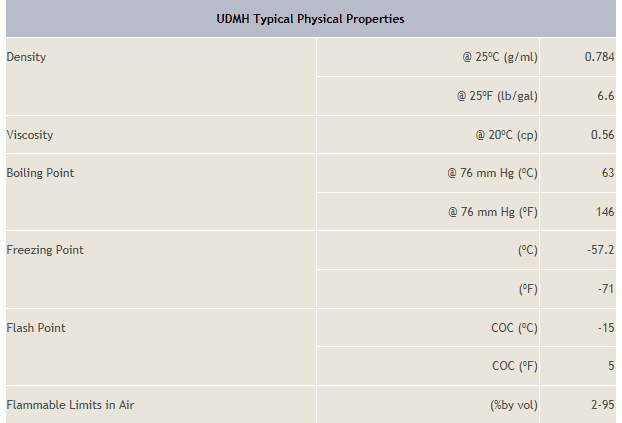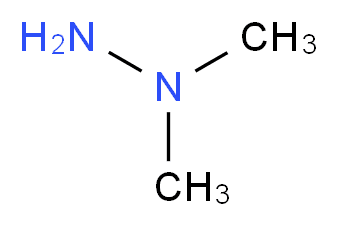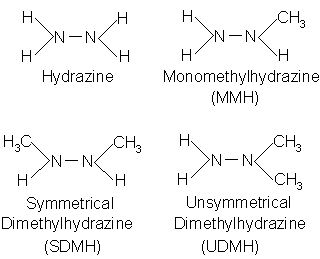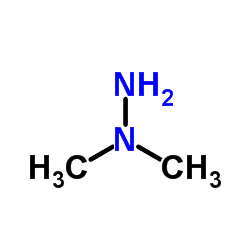Appearance Colourless liquid Molar mass 60.1 g/mol Boiling point 63 °C | Formula C2H8N2 Density 793 kg/m³ Melting point -58 °C | |
 | ||
Related compounds | ||
Unsymmetrical dimethylhydrazine (UDMH; 1,1-dimethylhydrazine) is a chemical compound with the formula H2NN(CH3)2. It is a colourless liquid, with a sharp, fishy, ammoniacal smell typical for organic amines. Samples turn yellowish on exposure to air and absorb oxygen and carbon dioxide. It mixes completely with water, ethanol, and kerosene. In concentration between 2.5% and 95% in air, its vapors are flammable. It is not sensitive to shock. 1,2-Dimethylhydrazine (CH3NHNH(CH3)) is also known but is not as useful.
Contents

Production

UDMH is produced industrially by two routes. One, based on the Olin Raschig process, involves reaction of chloramine with dimethylamine. This method gives the hydrochloride of the hydrazine:
(CH3)2NH + NH2Cl → (CH3)2NNH2 + HClAlternatively, acetylhydrazine can be N-methylated using formaldehyde to give the N,N-dimethyl-N'-acetylhydrazine, which can subsequently be hydrolyzed:
CH3C(O)NHNH2 + 2 CH2O + 2 H2 → CH3C(O)NHN(CH3)2 + 2 H2O CH3C(O)NHN(CH3)2 + H2O → CH3COOH + H2NN(CH3)2Uses

UDMH is often used in hypergolic rocket fuels as a bipropellant in combination with the oxidizer nitrogen tetroxide and less frequently with IRFNA (red fuming nitric acid) or liquid oxygen. UDMH is a derivative of hydrazine and is sometimes referred to as a hydrazine. As a fuel, it is described in specification MIL-PRF-25604.

UDMH is stable and can be kept loaded in rocket fuel systems for long periods, which makes it appealing for use in many liquid rocket engines, despite its cost. In some applications, such as the OMS in the Space Shuttle or maneuvering engines, monomethylhydrazine is used instead due to its slightly higher specific impulse. In some kerosene-fueled rockets, UDMH functions as a starter fuel to start combustion and warm the rocket engine prior to switching to kerosene. UDMH has higher stability than hydrazine, especially at elevated temperatures, and can be used as its replacement or together in a mixture. UDMH is used in many European, Russian, Indian, and Chinese rocket designs. The Russian Proton, Kosmos-3M, and the Chinese Long March 2F are the most notable users of UDMH (which is referred to as "heptyl" by Russian engineers). The Titan, GSLV, and Delta rocket families use a mixture of 50% hydrazine and 50% UDMH, called Aerozine 50, in different stages.
Apart from its use as rocket fuel, UDMH is a nitrogen source in metalorganic vapour phase epitaxy thin-film deposition. UDMH is a contaminant, metabolite, and breakdown product of daminozide.
Safety
UDMH is toxic, a carcinogen and can explode in the presence of oxidisers. It can be absorbed through skin. During the 1980s there was concern about the levels of UDMH in various foods being a cancer risk, especially for apple juice.
UDMH released into the environment can react in air to form dimethylnitrosamine, a persistent carcinogen and groundwater pollutant.
